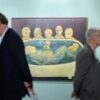
The fine art market has its challenges, and owners who want liquidity and the ability to change their holdings should consider the art finance market. We report a recent explanation about the state of the territory.
The global art market is at its lowest ebb in 35 years and
there’s a yawning gap between what sellers think their artworks
will fetch and what buyers want to pay, a senior figure in the
art finance sector has argued.
However, when people are not willing to sell their works of art
and are waiting for prices to revive, they can use their
collections as collateral for liquidity. This form of
finance does not receive the interest it merits, and is
an area requiring great expertise, Philip Hoffman (pictured),
founder and chairman, The Fine Art
Group, said at a briefing on the market in London.
“It is the best time to leverage your art,” Hoffman
said.
“Art finance is super-interesting and is massively underused in
Europe,” Hoffman said. “In the UK, a few people know about it.
Most of Europe barely knows it exists.”
Holders of fine art are typically asset-rich and cash-poor; there
are cases where people face estate taxes and are reluctant to
sell artworks at a large discount. As a result, they prefer to
borrow against their art if they are aware of the option.
Institutional money is looking at the art finance market, and
that should improve the state of it. “I think we will be able to
bring [buy-sell] spreads down,” Hoffman said, underscoring the
belief that greater participation from large, sophisticated
investors will help the market mature to mirror other
asset-backed lending sectors.
Hoffman spoke alongside Lindsay Dewar, chief operating officer
and head of analytics, ArtTactic, and Martin Schlombs,
associate, advisory, The Fine Art Group.
Interest in fine art can be a barometer of how confident high net
worth and ultra-HNW individuals feel about their finances and
state of the world. An idiosyncratic market, it is also driven by
emotion and aesthetic enjoyment, and prices fetched for artworks
frequently make headlines. Reports such as the annual Art
Basel/UBS studies shed a light on the state-of-the-art field and
open a window into the enthusiasms of the wealthy.
While banks such as Citigroup, for example, have art advisory
capabilities, in general banks have been reducing exposure to
alternative assets in the present market, Hoffman told the panel
event, held in the St James’s area of London’s West End. The Fine
Art Group offers loans from $1 million to $200 million, with a
maturity of two years initially with an option to extend.
Schlombs added that the loan-to-value ratio in this
collateralised art lending market was capped at around 50 per
cent.
There are other players in this space, but it is still a rarified
one: Sotheby’s Financial Services has a portfolio of art loans;
the alternative asset management house Yieldstreet, which bought
art-secured lender Athena in 2019, has reported that its members
made $1 billion of investments on its platform in 2022 (source:
The Art Newspaper, March 2023).
Market conditions have been difficult – and geopolitical
uncertainties may have added to the mix. To give a flavour of how
markets have performed, a report for May by ArtTactic on
New York “marquee evening auctions” this month was entitled
“Rising uncertainty keeps buyers and sellers on the
sidelines.” “This season’s results underscore the prevailing
caution in the market, closing 10.6 per cent below May 2024
levels and 7.6 per cent below those of November 2024. Although
the rate of decline appears to be levelling off, there was little
evidence this week to indicate a near-term recovery,” it said.
The Art Basel and UBS Art Market Report 2025 said sales
in the global art market declined by 12 per cent in 2024 to an
estimated $57.5 billion.
Opportunities
Hoffman said opportunities are considerable, with discounts on
art at around 20 to 40 per cent in the current market. However, a
challenge is that “most art owners are rich and don’t have to
sell,” he said. “There are tons of opportunities, but the
question is getting and buying the right things.”
“Without expertise, buying art and using leverage can be the
worst thing you can do,” he continued.
Hoffman said he works with several big banks and none of them
want to do pure art lending because they do not have the breadth
of in-house art and finance expertise like The Fine Art
Group.
He was asked whether he gets views from outside sources when
it comes to valuations. Hoffman replied that The Fine Art Group
has its own, deep in-house expertise to conduct valuations and a
separate appraisals business. He is wary of outside sources. “I
don’t want competitors valuing my art!” he replied.
The art-secured lending market could reach a market size between
$29 billion and $34.1 billion by the end of 2023, according to
the 8th edition of the Deloitte Private and ArtTactic Art &
Finance Report, issued in 2024. That report said that
art-secured lending was expected to grow 11 per cent in 2023.
Liquidity, in uncertain times, drove growth: 80 per cent of
private banks and 83 per cent of asset-based lenders identify it
as a key factor.
The report also noted that the “art-secured lending market has
gone global, with Asia – especially Hong Kong – and
Europe emerging as strategic markets for expansion.” Some 39
per cent of art-secured lenders regard Asia as a strategic market
for growth, a significant increase from 10 per cent in 2021,
while 78 per cent see Europe as an untapped opportunity. That
report said UHNW individuals’ and collectable wealth is estimated
to exceed $2 trillion. Of the stakeholders surveyed, from wealth
managers and collectors to art professionals, 89 per cent said
that art and collectable wealth should be part of a wealth
management offering.
Family offices are keen; they reported an average
allocation of 13.4 per cent to art and collectables (compared
with 8.6 per cent for private banks), the report said.
This post was originally published on this site be sure to check out more of their content






